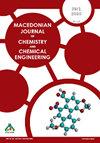马其顿蜂胶的酚类指纹图谱
IF 1.1
4区 化学
Q3 CHEMISTRY, MULTIDISCIPLINARY
Macedonian Journal of Chemistry and Chemical Engineering
Pub Date : 2024-05-19
DOI:10.20450/mjcce.2024.2862
引用次数: 0
摘要
蜂胶是蜜蜂(Apis mellifera)从树芽和树脂中采集的一种化学性质复杂的树脂材料,由植物渗出物、蜜蜂新陈代谢分泌的物质、花粉和蜡组成。蜂胶的化学成分在很大程度上取决于蜂巢周围的植物资源,这些植物资源对蜂胶的质量和生物活性有直接影响。本研究采用 HPLC-DAD-ESI-MS/MS 方法研究了 13 种马其顿蜂胶提取物中酚类化合物的组成。紫外光谱、质谱和 MS/MS 数据共鉴定出 36 种化合物。蜂胶的主要成分是酚酸(咖啡酸和香豆酸)及其酯(甲基、(异)炔基、苄基、苯乙基、肉桂基)、黄酮醇(槲皮素、山柰酚)、黄酮(金丝桃素、芹菜素、醋芹素)、黄烷醇(松柏苷)、黄酮(松柏苷柚皮苷、橙皮苷、松果菊苷)及其甲基化/酯化衍生物。研究结果表明,马其顿蜂胶含有多种酚类化合物,证实它是一种杨木型蜂胶,其酚类含量(从 43.75 至 637.94 毫克/克不等)高于该地区和欧洲以外地区以前的研究报告(小于 80 毫克/克)。这表明马其顿蜂胶是具有健康益处的生物活性化合物的宝贵来源,同时也为工业和养蜂业挖掘了经济潜力。本文章由计算机程序翻译,如有差异,请以英文原文为准。
Phenolic fingerprint of Macedonian propolis
Propolis is a chemically complex resinous material collected by honeybees (Apis mellifera) from tree buds and resins, comprising plant exudates, secreted substances from bee metabolism, pollen and waxes. Its chemical composition depends strongly on the plant sources available around the beehive, which have a direct impact оn the quality and bioactivity of the propolis.
In this study, the composition of phenolic compounds in 13 Macedonian propolis extracts was investigated by HPLC-DAD-ESI-MS/MS. Overall, the UV spectra, the MS and MS/MS data allowed the identification of 36 compounds.
The major constituents of propolis were phenolic acids (caffeic and coumaric) and their esters (methyl, (iso)prenyl, benzyl, phenylethyl, cinnamyl), flavonols (quercetin, kaemferol), flavones (chrysin, apigenin, acacetin), flavanonols (pinobanksin) flavanones (pinocembrin naringenin, hesperetin, pinostrobin) and their methylated/esterified derivatives.
The results reveal that Macedonian propolis contains a diversity of phenolic compounds confirming that it is a poplar type of propolis with higher phenolic content (ranging from 43.75–637.94 mg/g) than reported in previous studies in the region and beyond in Europe (< 80 mg/g). This suggests the potential significance of Macedonian propolis as a valuable source of bioactive compounds with health benefits as well as for unlocking its economic potential for industry and beekeepers.
求助全文
通过发布文献求助,成功后即可免费获取论文全文。
去求助
来源期刊
CiteScore
1.60
自引率
20.00%
发文量
14
审稿时长
>12 weeks
期刊介绍:
Macedonian Journal of Chemistry and Chemical Engineering (Maced. J. Chem. Chem. Eng.) is an official publication of the Society of Chemists and Technologists of Macedonia. It is a not-for-profit open acess journal published twice a year. The journal publishes original scientific papers, short communications, reviews and educational papers from all fields of chemistry, chemical engineering, food technology, biotechnology and material sciences, metallurgy and related fields. The papers published in the Journal are summarized in Chemical Abstracts.

 求助内容:
求助内容: 应助结果提醒方式:
应助结果提醒方式:


